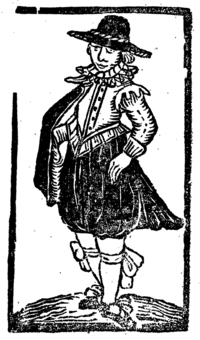How do you wear a cloak? Over both shoulders, just over your right or left shoulder, with one end over your arm, with the end pulled across your front, or with one lower corner thrown over a shoulder. All these variations appear in English broadside ballads of the seventeenth century. This is an examination of several images of men in cloaks that appear in the English Broadside Ballad Archive (EBBA). [1]
 |
| Figure 1: EBBA 30443 |
One of the issues with images on ballads is dating. The images range from those early enough to be wearing late Elizabethan trunk hose, to one wearing the wide bucket topped boots of the mid seventeenth century. Each of the images appear in a number of ballads, in the case of one image (EBBA Cluster Id:41), it is used in no less than thirty three different ballads. (Figure 1) Within the EBBA database images are often given a wide date range when the date of publication is unknown.
 |
| Figure 2: EBBA 20001 |
Are these images of the
wealthy, or of working men? They can be seen as a mixture of both. One image
which seems to contain two shepherds, first appears in the 1615? ballad, (EBBA 36112) “An excelent Ditty, called / The
Shepheards woing faire Dulcina,” (Figure 3) Both men carry shepherds crooks.
While the right hand figure has a cloak over his outfit, the left hand figure
wears a frock. A frock is an indicator of a working man, as the King James
Bible puts it (Ecc. 40, 4) “From him that weareth purple, and a crown,
unto him that is clothed with a linnen frocke”. The other male image on EBBA
36112, is of a more fashionable man. Most of the other cloak wearing images
depict men socially above shepherds.
 |
| Figure 3: EBBA 36112 |
The other image of a man
in a cloak that appears with the shepherds in EBBA 36112, also appears in EBBA
20088, “A merry Progresse to London to see Fashions, by a young Country
Gallant, that had more Money then Witte.” (Figure 4) In that ballad the
protagonist had inherited ten pounds from his dead mother, and went off to
London, where he spent all of it. Ten pounds for an agricultural worker was roughly
the equivalent of two years wages.[1]
The young man then complained that he had joined those “that for Drinke sell
their Cloathes, and for Tobacco My Cloake is layde to pawne.” It is interesting
that in this image the cloak is thrown over the shoulder. Pepys described his
servant Will walking “with his cloak flung over his shoulder, like a Ruffian.”[2]
The earliest appearance of this image in a surviving ballad is in EBBA 20041,
"Saint Georges commendation to all Souldiers," dated 1612. 
Figure 4: EBBA 20097
It is noticeable that several of the cloaks have obvious collars (Figures 1, 2, 4 and 5) Figure 5 appears in two ballads from about 1630.[1] The term collar is rarely used at the time, it is more commonly referred to as a cape. In a 1626 inventory a cloak is listed as being, without cape or lining.[2] Whether the cape/collar could be in the shape of, or usable as, a hood is a debateable point. In Greene’s Ghose a cheesemonger cuts a cheese in pieces and puts it “behind him in the cape of his cloak.”[3] The final image (Figure 6) is from EBBA 36078, The mournfull Shepherdesse of Arcadiah, from about 1649-50, here the excess fabric is pulled across his body, and the collar is just showing at the back.
By the second half of the seventeenth century the cloak had gone out of fashion, and while it still appears in broadsides it is only when earlier images are used. EBBA 21104 True love without deceit, was published in the early 1680s, it has the cloaked figure from EBBA 36112, which was first published in 1612, but the other woodcuts on the same ballad are nearer the 1680s in date, with one depicting a man in a periwig wearing a long coat with the pockets set low.
One ballad, which does not have an image of a man in a cloak, published in 1660 is making a political point, but foreshadowing the decline of the cloak. EBBA 31094 is entitled “The Cloak’s Knavery,” and it has the refrain “Then let us endeavour to pull the Cloak down, That crampd all the Kingdom and crippld the Crown.”
[1] Available at https://ebba.english.ucsb.edu Images from EBBA are licensed under a Creative Commons Attribution-NonCommercial 4.0 International License. For further information please use the EBBA site.
[2] This is based on the 1610 statutory wage rates in Norfolk in 1610.
[3] Pepys, Samuel. Diary. 8th June 1662
[4] EBBA 20100 and EBBA 30251
[5] Coleman, Moira. Household Inventories of Helmingham Hall 1597-1741. Woodbridge : Boydell Press for The Suffolk Records Society, 2018
[6] Rowlands, Samuel. The complete works of Samuel Rowlands, 1598-1628. Glasgow: The Hunterian Club, 1880. p18.


No comments:
Post a Comment
Note: only a member of this blog may post a comment.